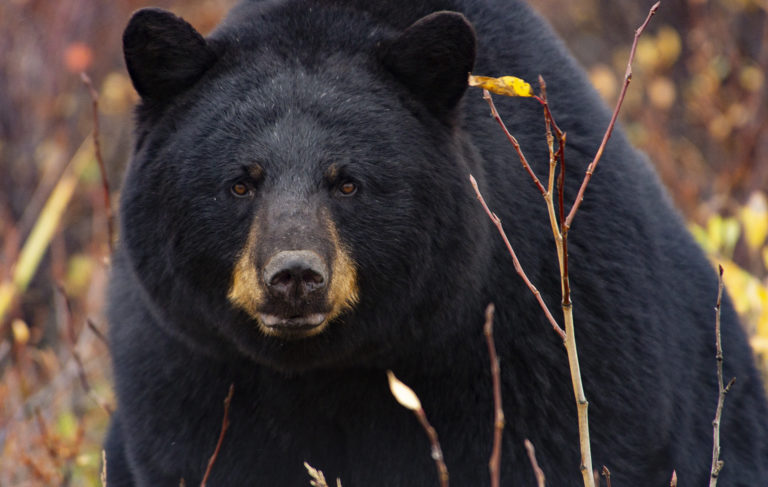The vastness of the Arctic wilderness conjures images of majestic creatures, and none are more iconic than the polar bear. These magnificent animals are synonymous with the icy north, their white fur blending seamlessly into the snowy landscape. Yet, across the globe, in the lush forests of North America, another bear species reigns supreme: the black bear. Both polar and black bears belong to the same family, yet they have evolved unique adaptations to thrive in vastly different environments.

Image: ar.inspiredpencil.com
The contrast between these two titans is stark. The polar bear, with its imposing size and thick white coat, is a symbol of cold and ice. The black bear, on the other hand, is known for its dark fur and agility in the dense forests. These differences extend beyond appearances, shaping their behavior, diet, and even their relationship with humans. Comparing these two bears allows us to understand the incredible diversity within the animal kingdom and the delicate balance of nature.
The Mighty Polar Bear: Ruler of the Arctic
A King of the Ice
The polar bear, aptly named Ursus maritimus, is the largest terrestrial predator on Earth. These giants are perfectly adapted for life in the Arctic, where temperatures can plunge to frigid lows. Their thick layer of blubber and dense fur provide insulation from the cold, while their large paws, equipped with rough pads and non-retractable claws, offer excellent traction on ice and snow. These adaptations are crucial for hunting their primary prey: seals.
A Masterful Hunter
Polar bears are opportunistic hunters, often waiting patiently near breathing holes in the ice or at seal haul-outs. When the opportunity arises, they strike with incredible speed and power, using their sharp claws and powerful bite to bring down their prey. Their diet is almost entirely composed of seals, with occasional scavenged carcasses enriching their meals. Polar bears play an essential role in the Arctic ecosystem, controlling seal populations and maintaining a delicate balance in the food web.

Image: churchillwild.com
A Changing Landscape
The polar bear’s future is inextricably linked to the health of the Arctic environment. As climate change leads to shrinking sea ice, their primary hunting grounds are threatened. This reduction in sea ice limits their access to seals, impacting their ability to successfully hunt and raise cubs. Conservation efforts are crucial to protect polar bears and their habitat, ensuring their survival in a changing world.
The Adaptable Black Bear: Master of the Forest
A Versatile Survivor
The black bear, known scientifically as Ursus americanus, is a remarkably adaptable species, found across a wide range of habitats from dense forests to open meadows. Their name is misleading, as their fur color can vary from black to brown, blonde, and even cinnamon. They display a remarkable ability to thrive in diverse environments, adapting their diet and behavior to the resources available in their surroundings.
Foraging Masterminds
Black bears are omnivorous creatures, with a varied diet consisting of berries, nuts, insects, fish, and even small mammals. They are incredibly adept at foraging, using their keen sense of smell to locate food sources, and their powerful claws to tear open logs and unearth hidden treasures. Black bears are also opportunistic scavengers, often feeding on carrion or garbage left behind by humans.
A Skilled Climber
Black bears are known for their climbing abilities, utilizing their sharp claws and powerful legs to navigate trees with ease. They often seek refuge in trees to avoid predators or to access high-hanging fruits. Their agility and intelligence make them highly adaptable, allowing them to thrive in a variety of landscapes and ecological niches.
Living Alongside Bears: Respect and Caution
Both polar bears and black bears are wild animals that should be treated with respect. While they generally avoid humans, it is crucial to take precautions when venturing into their habitats. Being aware of their presence, following safety guidelines, and minimizing human-bear interactions can help prevent conflicts and ensure the well-being of both humans and bears.
When visiting areas known to be inhabited by bears, it is essential to ensure that food sources are properly stored, preferably in bear-resistant containers. Leaving food unattended can attract bears, leading to conflicts and potential harm. It is also important to stay aware of your surroundings, make noise while hiking, and carry bear spray as a precautionary measure.
FAQs about Polar Bears and Black Bears
Q: What is the biggest difference between polar bears and black bears?
A:
The most significant difference lies in their habitat and diet. Polar bears are primarily adapted to the Arctic environment, relying on seals as their main food source. Black bears, on the other hand, thrive in forests and a variety of habitats, with a more diverse omnivorous diet.
Q: Can polar bears and black bears coexist?
A:
While both species belong to the same family, they are unlikely to share the same habitats. Their adaptations to different environments and dietary needs prevent them from overlapping significantly.
Q: Are polar bears more dangerous than black bears?
A:
Both polar bears and black bears have the potential to be dangerous if they feel threatened. However, polar bears are known for their aggressive hunting behavior, and their large size and powerful bite make them more formidable predators.
Q: What can I do to help protect polar bears and black bears?
A:
Supporting conservation efforts, reducing our carbon footprint, and promoting sustainable practices can all contribute to the well-being of these magnificent creatures.
Polar Bear And Black Bear
Conclusion
The polar bear and black bear are two iconic species that embody the incredible diversity of the animal kingdom. Their contrasting lifestyles, adaptations, and relationships with their environments highlight the delicate balance of nature. As we strive to protect these magnificent creatures, we must learn to respect their habitats and appreciate the crucial roles they play in our shared world.
Are you fascinated by the world of bears? Share your thoughts and any questions you may have in the comments below!





